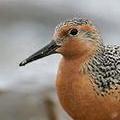 紅腹濱鷸是深受德拉瓦、紐澤西與維吉尼亞州地區賞鳥人喜愛的海濱候鳥,但牠的主要食物來源「馬蹄蟹」又再度無法爭取到該有的保育措施。1990年中期後,大量馬蹄蟹被捕捉用作餌料,導致德拉瓦灣的族群大量減少,進而導致紅腹濱鷸缺乏食物。
紅腹濱鷸是深受德拉瓦、紐澤西與維吉尼亞州地區賞鳥人喜愛的海濱候鳥,但牠的主要食物來源「馬蹄蟹」又再度無法爭取到該有的保育措施。1990年中期後,大量馬蹄蟹被捕捉用作餌料,導致德拉瓦灣的族群大量減少,進而導致紅腹濱鷸缺乏食物。
紅腹濱鷸每年春天會從南美洲移動到北極區,在這一萬英里的旅程中,牠們會在德拉瓦灣稍作停留,這些馬蹄蟹的卵便是牠們在該地的食物來源。如果不能得到蟹卵富有脂肪的營養,這些候鳥長途旅行能力就會下降,可能無法抵達他們在北極的繁衍地。
科學家指出紅腹濱鷸有可能在2010年就會絕種。然而在8月22日的一項會議中,大西洋州漁業管理委員會(ASMFC)馬蹄蟹管理小組並未同意在關鍵的幾州禁止捕捉馬蹄蟹,因為他們選擇跟漁民的短期生計利益站在一起,忽略了可憐候鳥的眼前苦難與長期生存的壓力。
管理小組不僅沒下禁補令,反倒繼續維持現有的捕撈配額,每州一年10萬隻雄蟹。美國鳥類保育會的施洛德(Darin Schroeder)說:「由這結果我們可以看出管理小組完全低估了馬蹄蟹與紅腹濱鷸的生存需求。」
在4月間,一份由聯邦政府與德拉瓦州漁業部門提供給ASMFC的報告中指出令人擔憂的情況,德拉瓦灣區外圍的紐約與麻州等地區的馬蹄蟹捕獲量增加,而同時德拉瓦灣區內的捕獲量卻減少。而在2008年初,管理小組查閱了2007年的調查之後說:「許多證據顯示德拉瓦灣的馬蹄蟹數量正在成長。」他們將在2009年實行下回的生物調查,並引進外部審理確認調查可信。
不過,保育人士並不相信這報告。
施洛德說:「ASMFC需要根本的變革,他們模糊失當的職權需要擴充,他們需要將受影響的海洋資源都納入考量,而不只專注於商業利益。」每年來自四方的愛鳥者為了一窺紅腹濱鷸湧入德拉瓦、紐澤西與維吉尼亞,但以後可能就再也沒有鳥可看,到時候再行動就來不及了。
2005年7月28日,德拉瓦週奧杜邦鳥會與其他8個保育團體,請求美國漁業與野生動物部將紅腹濱鷸的一個亞種(Calidris canutus rufa)列為瀕危物種,得以受到瀕危物種法(Endangered Species Act)保護,進而獲得重要的保護棲地。但他們的建議並未受到採納。
2008年3月,紐澤西州擴大了該州對捕捉馬蹄蟹的禁令,州長寇茲(Jon Corzine)將這個政策納入州法律,他說:「在漁業與野生動物部認定馬蹄蟹與紅腹濱鷸的數量回復到安全水準前,這禁令將會持續生效。」
The red knot, a migratory shorebird beloved by birdwatchers in Delaware, New Jersey, and Virginia, has again failed to win blanket protection of its major food source - horseshoe crabs. A sharp increase in the take of horseshoe crabs in the mid-1990s for use as bait in conch pots has diminished their numbers in Delaware Bay, leaving the birds short of food.
The red knot relies almost entirely on horseshoe crab eggs during an annual spring stopover in Delaware Bay on its 10,000 mile migration from the tip of South America to the Arctic. Without the fat-rich diet of horseshoe crab eggs, the bird's ability to successfully complete its long-distance migration to its breeding grounds in the Arctic is compromised.
Scientists have predicted that the red knot could go extinct as soon as 2010. But at a meeting on Friday, the Atlantic States Marine Fisheries Commission's Horseshoe Crab Management Board again failed to approve a moratorium on horseshoe crab fishing in the key states. They chose to support the short-term interests of crab fishermen while ignoring the immediate and long-term needs of the imperiled shorebird.
Instead of imposing a moratorium on horseshoe crab take, the board opted to maintain current fishing quotas, still permitting each state to take 100,000 male crabs per year. "By maintaining harvest levels rather than adopting a temporary moratorium on all horseshoe crab take, the Commission has dangerously underestimated the needs of both the crab and the Red Knot," said Darin Schroeder, vice president for conservation advocacy at American Bird Conservancy.
In April a report to the ASMFC Management Board by federal and Delaware state fish and wildlife agencies expressed concern over with horeshoe crab harvest increases in regions outside of Delaware Bay - in areas of Massachusetts and New York, at the same time as harvest reductions within Delaware Bay.
In early 2008, the board's Technical Committee looked at horsehoe crab survey data through 2007. "Data from multiple lines of evidence indicate that the Delaware Bay horseshoe crab population is experiencing positive population growth," they said. An external peer review of the next stock assessment is scheduled for 2009.
The committe's assessment is not convincing to conservationists. "There is a fundamental change required at the ASMFC Management Board. Their inadequate and blinkered mandate needs to be widened to include all marine resources affected by their actions, not just limited commercial interests," said Schroeder.
Each year birdwatchers flock to beaches in Delaware, New Jersey, and Virginia to see the staging birds. Soon, there could be no more knots to watch, and it will be too late to act, he said. On July 28, 2005, Delaware Audubon joined eight other environmental organizations in petitioning the U.S. Fish and Wildlife Service to list the rufa subspecies of the red knot, Calidris canutus rufa, as endangered and to designate critical habitat for the birds under the Endangered Species Act. Their petition was denied.
In March, New Jersey extended the state moratorium on horseshoe crab harvesting. "This moratorium will be held in place until the populations of both horseshoe crabs and red knots have returned to a level where they will be self sustaining as determined by the U.S. Fish and Wildlife service," pledged Governor Jon Corzine as he signed the measure into law.
全文及圖片詳見:ENS





